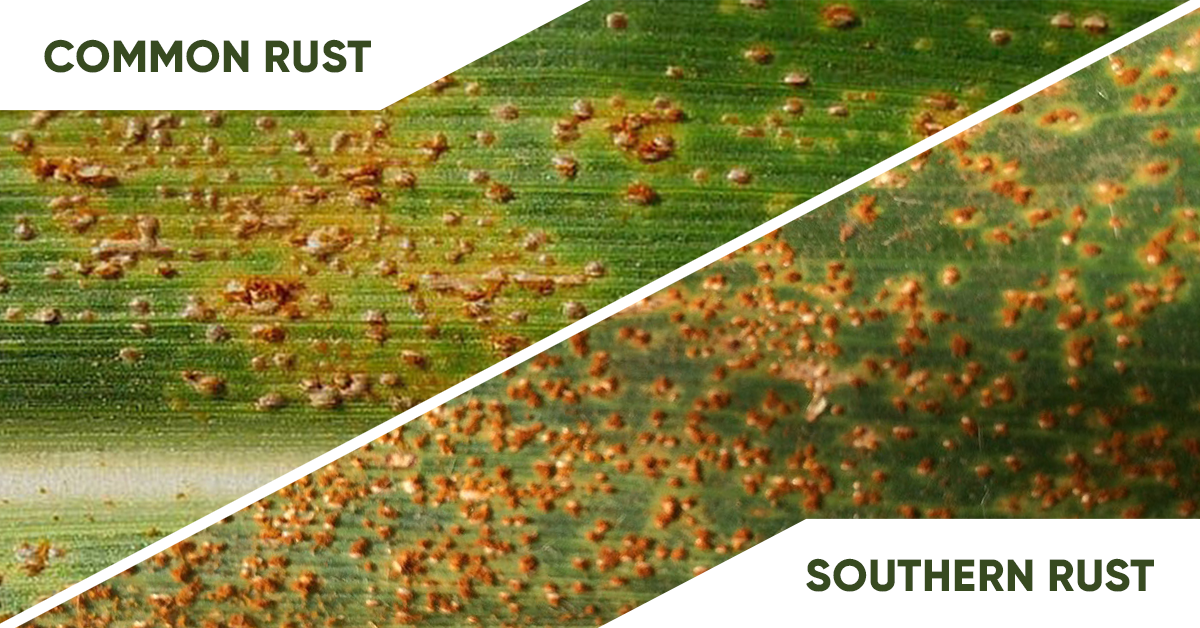Southern rust usually occurs later in the growing season and is more prevalent in the Southern states. However, this disease can be found periodically throughout the Corn Belt. Southern rust does not occur as often from year to year as common rust but is usually more severe when it does occur.
- Common name: Southern rust
- Scientific name: Puccinia polysora
- Symptoms: Southern rust looks very similar to common rust, but several characteristics distinguish the two.
- Southern rust pustules are usually confined to the upper leaf surface, while common rust is found on both upper and lower surfaces.
- Southern rust is more orange or reddish orange in appearance, while common rust is red or cinnamon brown.
- Southern rust pustules have a circular appearance, while those of common rust have an elongated, jagged appearance.
- Conditions for development: This disease can develop very rapidly during warm, humid conditions.

Fast facts:
- Unlike other major foliar diseases of corn in North America, the rusts do not overwinter in the Corn Belt.
- Rusts develop first in Southern cornfields and then may spread into primary corn-growing states.
- Movement is by windblown spores that travel north with prevailing weather systems.
- Yield loss due to southern rust will depend on the timing of infection, amount of leaf area damaged and the location of damaged leaves on the plant.
- If significant damage to upper leaves occurs early in the life of the hybrid, yield losses will be higher.
- If damage is confined to lower leaves of the corn plant or occurs in the later stages of development, little economic loss can be expected.
- Consequently, the latest-planted corn in an area is at higher risk for yield loss due to leaf diseases.
Control tips:
- According to the University of Nebraska, resistant corn varieties are the most cost-effective means to manage southern rust in field corn.1
- Encourage customers to scout for foliar diseases like southern rust.
- Begin scouting two weeks before tasseling and watch for southern rust until two weeks after tasseling.
- Check for disease in both the lower and upper levels of corn when scouting for southern rust.
- If applied properly and in a timely manner, fungicide treatments can be effective in protecting corn leaves from foliar diseases. It’s critical to apply the fungicide with the correct water volume for maximum disease control.
- Fungicide treatments are more likely to be profitable during severe rust outbreaks while corn prices are high and with disease present on younger-stage corn. When determining if application is warranted, factors to consider include:
- The crop stage
- The severity of the infection at the time of application
- The weather forecast being conducive to disease development
- The probability of other fungal leaf blights developing in the field
- The price of corn
- The cost per application
- Aproach® Prima fungicide from Corteva Agriscience has two modes of action that provide excellent control of this disease. Consult your local Corteva Agriscience representative to determine when an application of Aproach Prima makes sense for your customers’ acres.
1University of Nebraska-Lincoln CROPWATCH. 2022. Southern Rust. https://cropwatch.unl.edu/plantdisease/corn/southern-rust
Aproach® Prima is not registered for sale or use in all states. Contact your state pesticide regulatory agency to determine if a product is registered for sale or use in your state. Always read and follow label directions.

